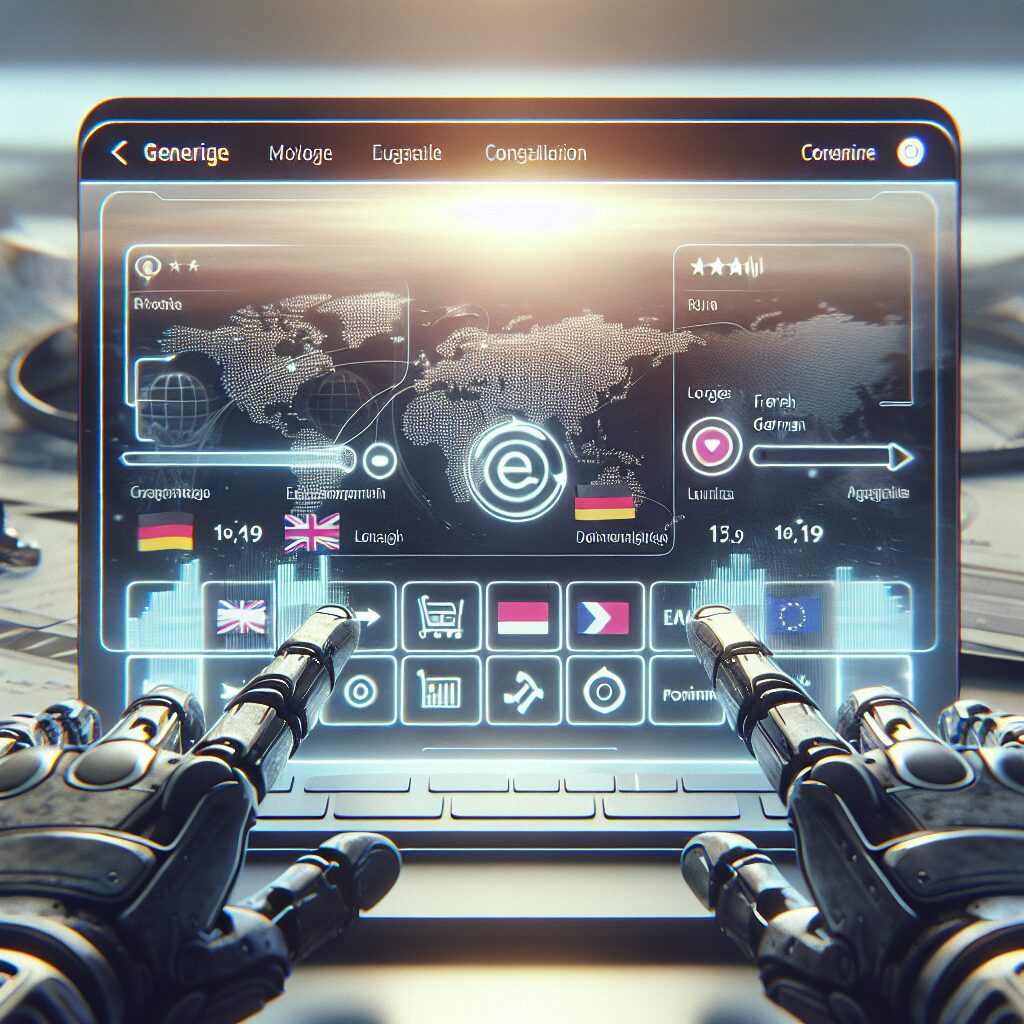About eldris
Clone.Eldris.ai empowers brands to instantly replicate and translate their websites for seamless global expansion. Our automated system delivers SEO-friendly, multilingual clones that launch in days, not months.
In This Article
- Start your Shopify translation France initiative early—competitive advantage lies in timing.
- Use hybrid strategies combining AI speed with human nuance.
- Leverage automatic compliance and multilingual navigation tools.
- Optimise for localised SEO with language-specific URLs and content.
- Partner with experts when handling cultural or legal localisation.
Why Fast Translation Matters in 2025
Global Market Expectations
As we approach 2025, cross-border eCommerce is no longer a luxury—it’s an expectation. For online retailers using Shopify, targeting international consumers, particularly in Europe, necessitates rapid localisation. This is especially true in the case of Shopify translation France where the demand for tailored, linguistically accurate content is immense. French consumers expect an entirely localised experience—not a clumsy overlay of machine-translated content. They seek websites that reflect their language, culture, currency, and legal norms. Fast and precise translation is not just about appealing to users’ preferences; it’s also at the heart of conversion optimisation and brand trust.
Moreover, as the European Digital Services Act comes into full force by 2025, compliance becomes mandatory, especially in key markets like France and Germany. This legal landscape enforces transparency and language clarity for consumers, elevating the importance of prompt and reliable site translation. If your Shopify store overlooks fast, localised content delivery, you’re likely to miss out on growth opportunities and may even incur compliance penalties. Ultimately, in markets like France and Germany, speed isn’t just a competitive advantage—it’s part of the legal and commercial terrain itself.

Top Translation Tools Compared
AI vs Manual Solutions
When it comes to Shopify translation France, the debate between using AI-based tools and manual human translators remains deeply relevant. Automated tools such as Google Translate, DeepL, and Shopify’s built-in Translate & Adapt app offer rapid deployment of translated content with minimal input. These tools use natural language processing and AI learning to deliver surprisingly nuanced translations, particularly suitable for product descriptions and standard site navigation elements.
However, AI tools falter when handling culturally specific language, regional idioms, or industry-specific terms. Manual translation—especially when paired with professional localisation services—remains unmatched in its ability to convey brand voice and connect with customers on a deeper level. Yet, this quality comes with a significant time and cost commitment.
Companies expanding to France must weigh the balance between speed-to-market and cultural resonance. A hybrid approach is often best: initial content launches using AI systems for baseline speed, followed by selective manual refinement on core pages. This strategy allows Shopify merchants to enter foreign markets rapidly while preserving brand identity and linguistic accuracy.
“A fast, localised presence is now a baseline for Shopify stores eyeing Europe—not a differentiator.” – Industry Analyst, 2024
Shopify’s Built-In vs Third-Party Translation
Shopify’s native Translate & Adapt feature is an excellent starting point for merchants targeting the French and German markets. It allows language duplication of existing content and integrates seamlessly with Shopify Markets. Nonetheless, its functionalities are limited to static text and do not provide substantial customisation options for product variants, dynamic fields, or metafields critical to European compliance and UX expectations.
Third-party apps such as Langify, Weglot, and GTranslate bridge these functionality gaps by offering deeper integration and fluidity. They support comprehensive SEO benefits, advanced metrics, A/B testing for translated content, and even visual editing interfaces. For Shopify translation France in particular, Weglot’s premium version provides French grammar and spelling optimisation tailored to eCommerce industries.
It is essential to determine whether your distribution strategy is regionally nuanced or globally uniform. For custom regional campaigns or France-exclusive deals, third-party apps offer greater speed and adaptability unmatched by Shopify’s native tool.
Speed-to-Market Advantage in France & Germany
The speed at which you can deploy fully translated and localised content directly correlates with revenue capture, especially in markets as competitive as France and Germany. Shopify stores that employ pre-approved glossaries and machine translation rule sets can shortcut weeks—if not months—of localisation efforts. That’s crucial when launching seasonal campaigns or entering competitive niches like beauty, fashion, or electronics.
For example, in France, Black Friday and Les Soldes d’Hiver (winter sales) are massive revenue generators. Releasing translated landing pages and targeted ads weeks in advance can determine your success. Similarly, in Germany, where consumer punctuality and information transparency are cultural norms, rapid localisation of return policies and delivery timelines enhances buyer trust. Brands that delay their Shopify translation France strategy often find themselves reacting rather than leading the market.
Comprehensive Shopify translation app comparison
Setting Up Multilingual Shopify Navigation
One often-overlooked component of Shopify translation France is multilingual navigation. Simply translating text doesn’t guarantee a good user experience. Navigation must feel native to French and German users—meaning categorisation logic, menu structure, and terminology must reflect local expectations. In France, for instance, product subcategories often follow different logic than in Anglo markets. A “Home Décor” section might be more broadly grouped under “Maison” rather than split into granular departments.
Shopify enables multiple navigation menus for different locales, and many translation apps allow dynamic rendering based on user region or language preference. Ensure your store’s theme supports dynamic multilingual architecture or use Liquid code and alternate URLs to render language-specific layouts. Remember, the easier the navigation, the higher the engagement and conversion rate from local users.
Boosting SEO with Language-Adaptive URLs
Another major factor in any Shopify translation France strategy is ensuring search engine discoverability for each language version. Multilingual SEO requires more than translated keywords—it demands language-differentiated URLs, properly configured hreflang tags, and unique content per locale. Shopify provides some support but often relies on translation apps like Langify or Weglot to deliver full SEO compliance.
Language-adaptive URLs such as /fr/products/canapes instead of generic /products/sofas offer more than readability—they’re critical for hyperlocal SEO. Google’s French and German search engines rank localised content higher, especially when supported by proper schema.org markup and meta descriptions in the target language. Local SEO ensures visibility in voice search as well as text queries—a growing trend among mobile and Gen-Z users.
Learn more about Multilingual Localisation for European Shopify Expansion
How Automation Ensures Compliance & Speed
With increasing EU regulation, automation of Shopify translation France ensures that costly compliance checks are met swiftly and reliably. From GDPR disclosures to cookie banners and terms of service, legal content must be continuously updated and accurately translated in the local legal language. Automation tools that sync legal content across all language versions ensure consistency and reduce legal risk.
Advanced translation software can be connected to a style guide or glossary, ensuring all instances of required terminology—such as “livraison gratuite” for free shipping—are correctly deployed. Moreover, dynamic product feeds, blog content, and email marketing campaigns can be auto-translated and segmented, guaranteeing speed and consistency across platforms.
Adapting Content to Local Culture and Idioms
Culture matters, especially when your brand storytelling relies heavily on emotionally resonant messaging. While AI can translate syntax and grammar, it often misses tone and contextual cues. For Shopify translation France, adaptation to local customs, colour associations, humour styles, and consumer expectations can dramatically alter campaign effectiveness.
For instance, “back-to-school” in France may be locally interpreted as “rentrée scolaire,” which carries different marketing rhythms and connotations. Tactfully adapting such themes in homepage sliders, blog content, and promotional banners sets successful brands apart. This nuance often demands native speakers or cultural consultants, but the payoff in customer engagement is unmistakable.
EU compliance essentials for online sellers
Lessons From Brands That Scaled EU Faster
A notable case is an eco-friendly cosmetics company that achieved a 40% increase in conversion rates after implementing Shopify translation France-specific strategies. Initially using automated tools, they quickly realised the necessity of blending AI translation with human editing and cultural adaptation. By the time they expanded to Germany, they had developed playbooks for rapid localisation, including translation glossaries and automated compliance banners.
Another success story involves a fashion retailer that launched in both France and Germany simultaneously, using Shopify Markets and Weglot’s Smart Translation Layer. Within three weeks, they hit 10,000 sales with under 2% cart abandonment. Their takeaway? Launch slow, then optimise fast.
Final Thoughts for Your 2025 Expansion Strategy
[CONCLUSION_CONTENT]
Great guide on shopify-france-germany-fastest-translation-2025 – Community Feedback
What is the fastest way to translate a Shopify store for France and Germany?
Automated AI-driven translation apps like Translate Language Auto or Transcy offer near-instant translations. For best results in 2025, integrate with solutions that generate SEO-friendly URLs and adapt content for local nuances.
Are Shopify’s built-in translation options suitable for EU market entry?
Shopify’s built-in tools are quick for basic translation but may lack advanced localisation and SEO features needed for France and Germany. Consider specialised apps or platform integrations for a robust multilingual setup.
How can translation speed affect my EU launch?
Rapid translation enables faster market entry, quicker compliance, and early exposure in SERPs. Delays can hinder competitive positioning and lose sales—automation supports fast, localised launches in competitive regions.










